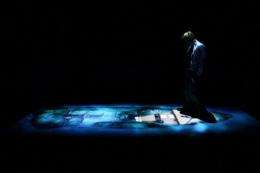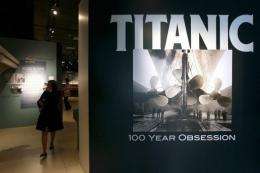Litter bugs on high seas foul Titanic's resting place

Litter bugs on the high seas are fouling the Titanic's watery grave with beer cans, plastic cups, even soap boxes, a century after the "unsinkable" luxury liner went down, experts said Wednesday.
Contrary to popular belief, the wreck of history's greatest maritime disaster is not swiftly rusting away 12,400 feet (3,780 meters) under the North Atlantic. In fact, it looks likely to stay intact for many decades to come.
"The basic hull remains very strong and very solid," James Delgado, director of the marine heritage program at the National Oceanic and Atmospheric Administration (NOAA), a US federal agency, told AFP.
"You still have wood and fabric preserved inside," said Delgado, who personally saw the Titanic up close from inside a Russian Mir submersible vehicle during a August 2010 expedition to precisely map its vast debris field.
"There has been some speculation that it's basically been rusting away and won't exist in 20 or 30 years," agreed Jamie Shreeve, who has closely followed the Titanic saga as science editor of National Geographic magazine.
"But the most reliable people that I've talked to don't think that it's going away any time soon," he said on the eve of a National Geographic Society exhibition on the Titanic and its legacy. "It's just too slow a process."

However, ever since the Titanic hit an iceberg four days into its maiden voyage from Southampton, England to New York and sank in the early hours of April 15, 1912 with the loss of more than 1,500 lives, its final resting place has been marred by rubbish tossed from passing vessels.
"Beer cans, plastic cups, that sort of thing," Delgado said. "We even found a detergent box lying in the middle of the wreck site... That garbage is going to be around for a very long time."
Private deep-sea excursions -- available for $60,000 (45,000 euros) per person -- have also left their mark, with visitors laying memorabilia in the vicinity of the Titanic's bridge, Shreeve said.
"Everybody who dives down there leaves plastic flowers or a plaque or something," he said. "It sort of looks like one of those places where there's been an accident on the highway... Basically, it's an archeological site that's no longer pure."
Submersibles have dropped weights onto the wreckage also, although Delgado said that now is less of an issue thanks to better mapping identifying safer places for weights to be positioned.
Delgado is closely involved with ongoing efforts to forge a consortium to safeguard the Titanic's final resting place -- which lies in international waters -- and declare it a protected maritime memorial.
Earlier this year, the International Maritime Organization, through its member states, advised all vessels not to discharge garbage, waste or effluent in a 10-square-mile (35-square-kilometer) zone above the wreck.
"The Titanic is in greater peril than ever before," said oceanographer Robert Ballard, who led the 1985 expedition that found its wreckage, in a National Geographic television documentary to premiere on April 9.
A "scientifically accurate" scale model of the Titanic's forward half is among the highlights of the "Titanic: 100 Year Obsession" exhibition at the National Geographic Society's headquarters in Washington from Thursday.
Running until July 8, the show reflects on how the world's then biggest ship snapped in half and plummeted to the depths of the icy Atlantic, and considers how its loss still shapes the way the world perceives disasters.
More than 5,500 items plucked by salvagers from the Titanic wreck site, from a 17-ton piece of its hull to china used to serve first-class passengers, are to be sold as one collection to the highest bidder in New York next month.
(c) 2012 AFP




















